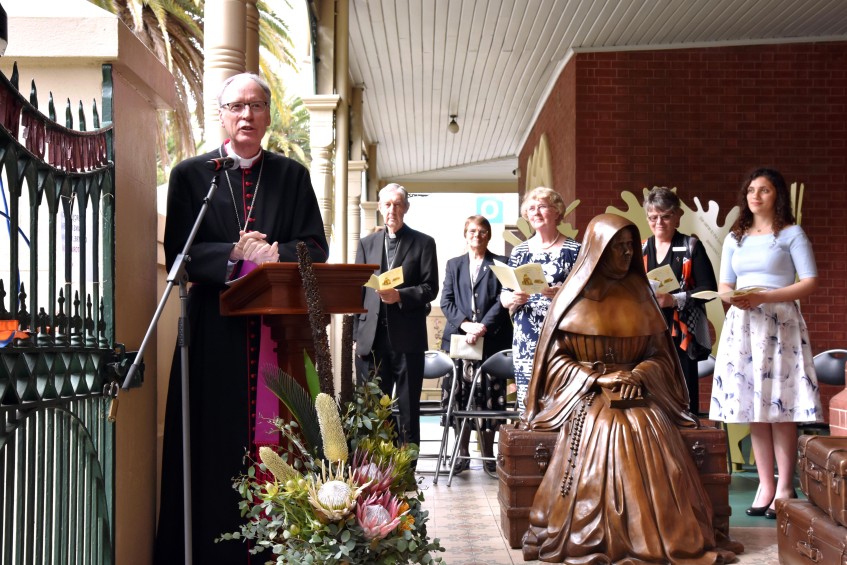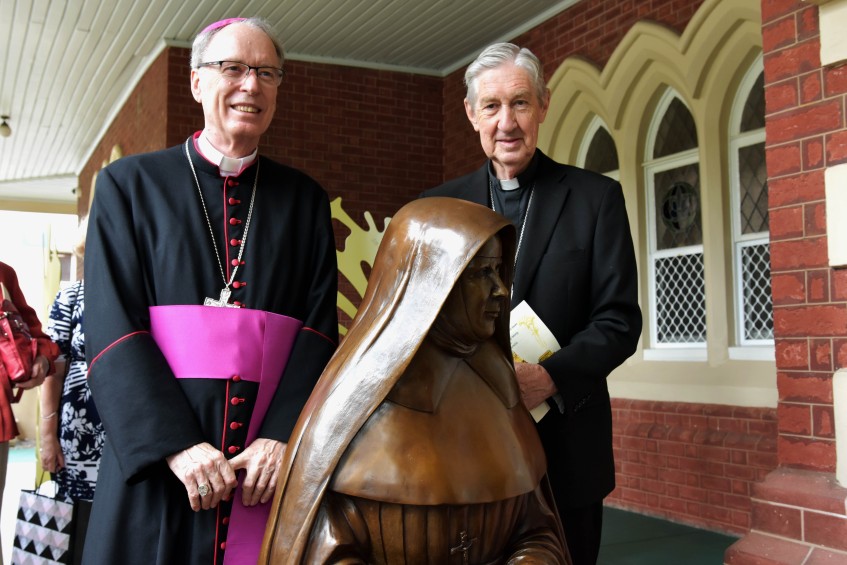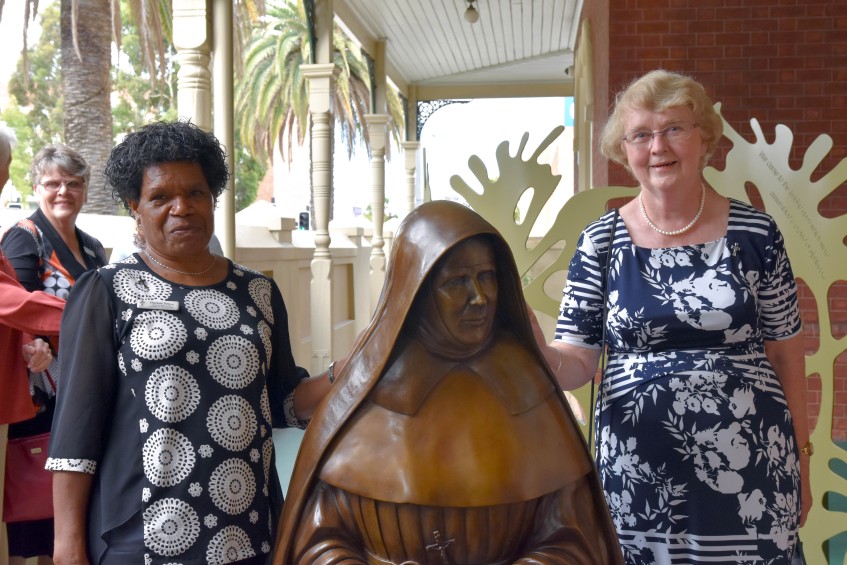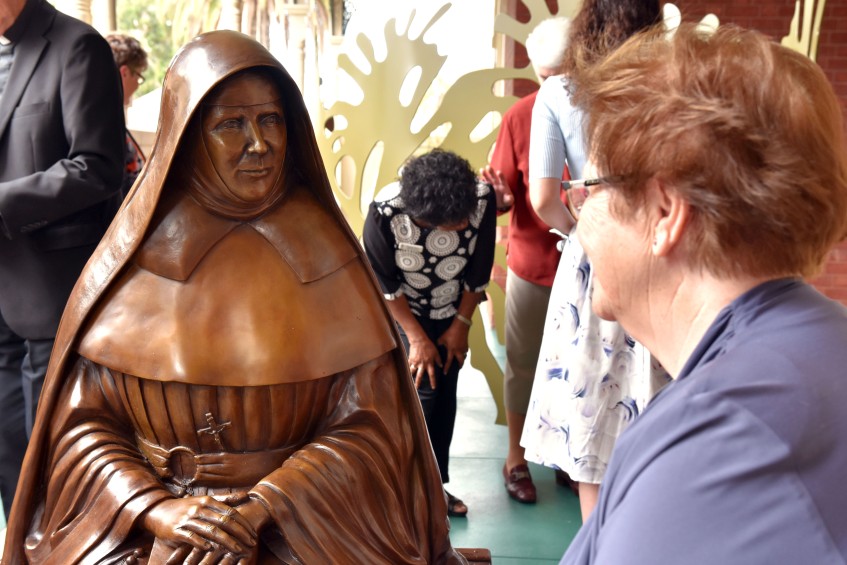Legacy of Sisters of Mercy lives on with unveiling of Ursula Frayne sculpture

Perth Auxiliary Bishop Donald Sproxton honoured the outstanding work of Sisters of Mercy in Australia and applauded Ursula Frayne’s faith and courage. Photo: Feby Plando
By Marco Ceccarelli
In one of this year’s final events celebrating the 170 year anniversary of the Sisters of Mercy’s arrival to Western Australia, Perth Auxiliary Bishop Donald Sproxton unveiled and blessed a life-size bronze sculpture of Mercy Sister Ursula Frayne.
“Traveller”, as the statue is called, was unveiled at the Mercy Heritage Centre on 12 December – a date known to the Sisters of Mercy as “Foundation Day” for it commemorates the founding of their order by Catherine McAuley in 1831.
The event honoured the outstanding work of the Sisters of Mercy in Australia and applauded Ursula Frayne’s faith and courage as a pioneer who brought her order’s spirit of mercy to the shores of the Swan River in January 1846.

Perth Auxiliary Bishop Don Sproxton (left) and Emeritus Archbishop Barry Hickey (right) stand behind the newly unveiled bronze statue of Ursula Frayne. Photo: Feby Plando
“It is very important that we are all here and able to celebrate the life of this extraordinary and wonderful woman,” Bishop Sproxton said.
“The reading from the Gospel of Luke, the Magnificat, helps us to focus on how a woman came here without very much but who was able to achieve a great deal because of her trust in God.
“It is in that spirit that we gather here today, remembering her and remembering that faith that unites us, that faith in our God, who supports us and blesses us in our endeavours.”

Members of the Leadership Team of the Institute of the Sisters of Mercy Australia and Papua New Guinea, Sister Theresia Tina and Sister Barbara Bolster, stand behind the newly unveiled bronze statue of Ursula Frayne at the Mercy Heritage Centre. Photo: Feby Plando
Bishop Sproxton went on to bless the specially commissioned sculpture along with two story screens featuring engraved excerpts from the history of Sister Frayne’s journey to Australia and the Heritage Centre Door of Mercy.
Attendees were also treated to a soloist performance of the Suscipe of Catherine McAuley – a moment of reflection which brought the charism of the Sisters of Mercy to the fore in the context of such a significant year for the order.
My God, I am yours for time and eternity. Lord, I am yours forever
It is you who must teach me to trust in your providence, Loving Lord
You are a God of love and tenderness I place my trust in you
And I ask that you grant me acceptance of your will, Loving Lord.
Take from my heart all painful anxiety. Let nothing sadden me but sin.
And then let my delight be hoping to see your face, God my all.
My God, I am yours for time and eternity. Lord, I am yours forever.
It is you who must teach me to trust in providence, Loving Lord.
Catherine McAuley

A prayerful and engaging woman, Ursula Frayne is depicted sitting on a steamer trunk with her hands resting on her breviary. She looks at the viewer who may choose to sit on the opposite suitcases, inviting them to commute with her. Photo: Feby Plando
A symbolic sculpture depicting courage, faith, travel and prayer
Sister Ursula Frayne was an intrepid, resourceful traveller who, with a brave band of Sisters, crossed the world to share the Gospel message of mercy, justice and compassion. She was a woman who had the courage of her convictions and who adhered faithfully to the legacy of Catherine McAuley, even when this caused conflict with figures of authority, and made her own life journey more difficult.
It is fitting that Sister Frayne is depicted sitting on a steamer trunk, so symbolic of the arduous journey she made to come to Australia by sailing ship. A prayerful, engaging woman, she is sitting calmly with her hands gently resting on her breviary. She looks at the viewer who may choose to sit on the opposite suitcases, inviting them to commute with her.
Sister Frayne was a migrant coming to an unknown place. Not knowing if she could ever return to her home country, her trunk becomes symbolic of her transition into exile and a new beginning in a new country. The trunk is a metaphor for traveling as well as for the few possessions Sister Frayne and her group of sisters brought along with them.
